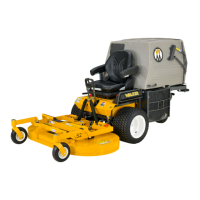Operating Instructions
44
● When mowing, operate the engine at full throt-
tle for the best cutting action and performance of the
grass handling system (GHS). Mowing with a lower
engine RPM causes the mowing blade to not cut
clean and tear the grass. The engine is designed
to be operated at full speed.
● When mowing in adverse conditions (tall and/or
wet grass), mow the grass twice. Raise the mower
to the highest setting - 4 in. (102 mm) - for the rst
pass and then make a second pass cutting to the
desired height.
● Use a slow setting on the FSC for trimming
operations.
● Make sure the mower is leveled properly for a
smooth cut. Refer to Deck Leveling in Assembly
Instructions.
● Use an alternating stripe mowing pattern for
best appearance and vary the direction of the stripe
each time the grass is mowed to avoid wear patterns
in the grass.
● Avoid damage to the grass by slipping and skid-
ding of the drive tires. Use smooth control move-
ments of the steering levers since the hydrostatic
transmissions are “power boosted controls” and
jerk ing the levers can easily slip the tires. For sharp
turns, do not allow the inside wheel to stop and twist
on grass; pull inside steering lever into reverse for a
smooth “rolling” turn (one wheel rolling forward while
the other rolls backward).
● When using a side discharge mower deck, the
side discharge deector shield must not be re-
moved and must be kept in the lowest possible po-
sition to deect grass clippings and thrown objects
down ward. Orient the side discharge away from
side walks or streets to minimize cleanup of clip-
pings. When mowing close to obstacles, orient the
side dis charge away from obstacles to reduce the
chance of damage to property by thrown objects.
Discharge
Shield
Side Discharge Deector
Shield in Lowest Position
● When operating on a slope, reduce speed and
use caution to start, stop, and maneuver. Avoid
sharp turns or sudden changes in direction. The
maximum recommended slope operating angle
is 15 degrees or 26% grade.

